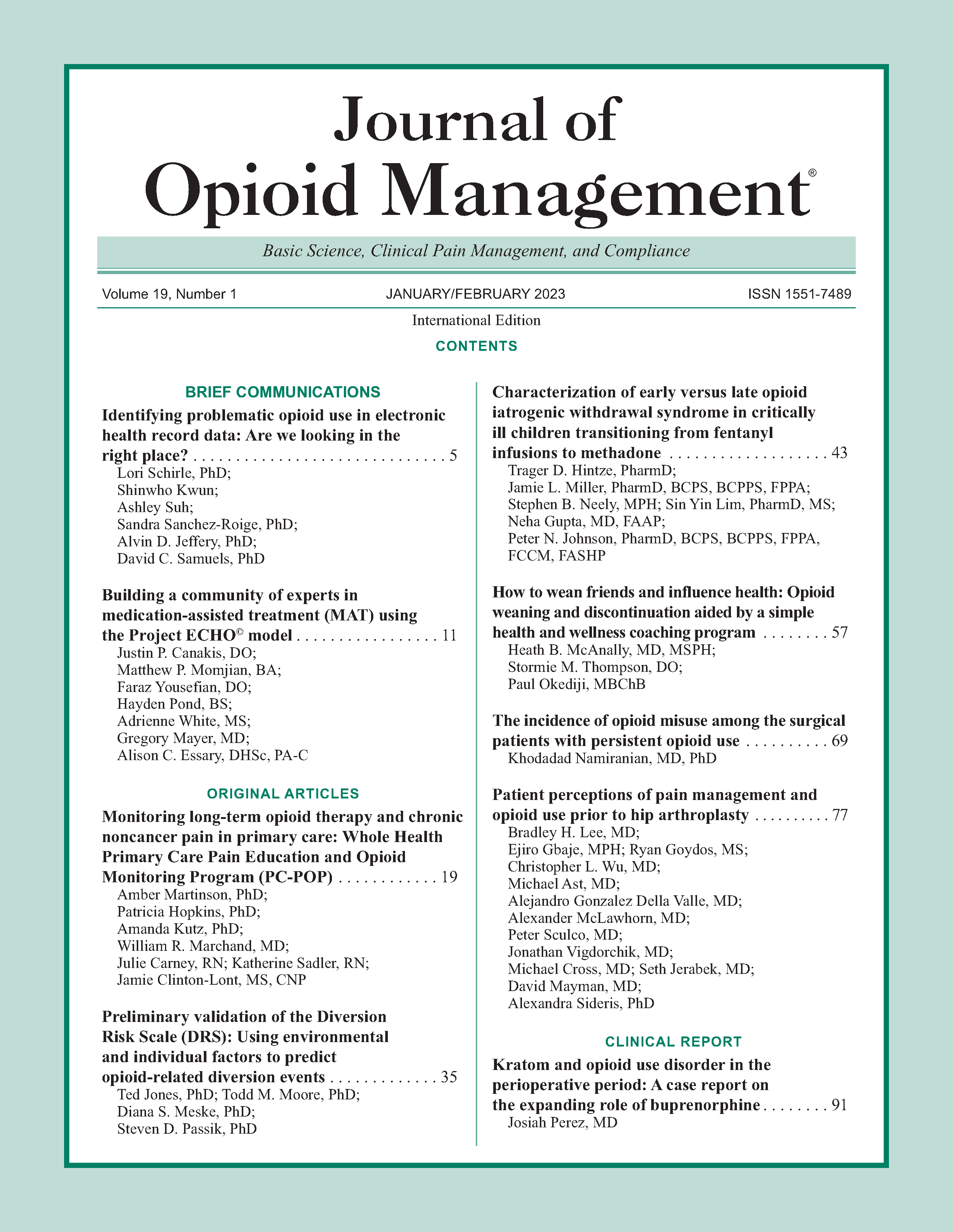The incidence of opioid misuse among the surgical patients with persistent opioid use
DOI:
https://doi.org/10.5055/jom.2023.0760Keywords:
chronic opioid use, post-operative, opioid misuseAbstract
Objective: To calculate the monthly incidence of opioid-related adverse events in the opioid-naïve patients who continue to use opioids in the post-operative period.
Background data: An estimate of 1-6 percent of surgery patients continues to persistently use the opioids longer than 90 post-operative days. However, the association of the opioid adverse events with the persistent post-operative use is not clearly known.
Methods: This is a historical (retrospective) cohort study of the opioid-naïve US Veterans between the ages of 18 and 85. The surgical group (who had major surgery between January 1, 2008 and December 31, 2015) was compared to the control references. The outcome of opioid misuse was either opioid overdose or the development of opioid use disorder. Each case was followed for 13 months. The monthly incidence of opioid misuse was calculated by dividing the number of new opioid misuse divided by the number of patients who are still filling the prescription for opioid medications in that specific month.
Results: A total of 150,088 surgical patients and 1,145,553 controls met the inclusion criteria. The risk of opioid misuse was between 0.3 and 1.8 percent for first 11 post-operative months among both groups. The incidence of opioid misuse increases to 4.6 percent (95 percent CI: 3.2-6.4) at 12 months and to 8.1 percent (95 percent CI: 5.6-11.5) at 13th post-operative month. The incidence also increases to 2.3 percent (95 percent CI: 1.6-3.4) at 12th and 3.9 percent (95 percent CI: 2.5-6.0) at 13th follow-up month among the control references.
Conclusions: After initiation of opioid prescription, the opioid misuse occurs, and the incidence increases dramatically after the 11th month regardless of the reason for opioid therapy initiation (surgery vs chronic conditions). The risks/benefits of opioid use must be evaluated more frequently with the longer opioid use.
References
Sun EC, Darnall BD, Baker LC, et al.: Incidence of and risk factors for chronic opioid use among opioid-naïve patients in the post-operative period. JAMA Intern Med. 2016; 176(9): 1286-1293.
Brummett CM, Waljee JF, Goesling J, et al.: New persistent opioid use after minor and major surgical procedures in US adults. JAMA Surg. 2017; 152(6): e170504.
Cauley CE, Anderson G, Haynes AB, et al.: Predictors of in-hospital post-operative opioid overdose after major elective operations: A nationally representative cohort study. Ann Surg. 2017; 265(4): 702-708.
Ladha KS, Gagne JJ, Patorno E, et al.: Opioid overdose after surgical discharge. JAMA. 2018; 320(5): 502-504.
Chou R, Turner JA, Devine EB, et al.: The effectiveness and risks of long-term opioid therapy for chronic pain: A systematic review for a national institutes of health pathways to prevention workshop. Ann Intern Med. 2015; 162(4): 276-286.
Deyo RA, Von Korff M, Duhrkoop D: Opioids for low back pain. BMJ. 2015; 350: g6380-g6380.
Deyo RA, Hallvik SE, Hildebran C, et al.: Use of prescription opioids before and after an operation for chronic pain (lumbar fusion surgery). Pain. 2018; 159(6): 1147-1154.
Namba RS, Inacio MCS, Pratt NL, et al.: Persistent opioid use following total knee arthroplasty: A signal for close surveillance. J Arthroplast. 2018; 33(2): 331-336.
Smith ME, Lee JS, Bonham A, et al.: Effect of new persistent opioid use on physiologic and psychologic outcomes following bariatric surgery. Surg Endosc. 2019; 33: 2649-2656.
Brat GA, Agniel D, Beam A, et al.: Postsurgical prescriptions for opioid naïve patients and association with overdose and misuse: Retrospective cohort study. BMJ. 2018; 360: J5790.
Hah JM, Bateman BT, Ratliff J, et al.: Chronic opioid use after surgery: Implications for perioperative management in the face of the opioid epidemic. Anesth Analg. 2017; 125(5): 1733-1740.
Siglin J, Sorkin JD, Namiranian K: Incidence of post-operative opioid overdose and new diagnosis of opioid use disorder among US veterans. Am J Addict. 2020; 29(4): 295-304.
Namiranian K, Siglin J, Sorkin JD: The incidence of persistent post-operative opioid use among US veterans: A national study to identify risk factors. J Clin Anesth. 2021; 68: 110079.
Namiranian K, Siglin J, Sorkin JD, et al.: Post-operative opioid misuse in patients with opioid use disorders maintained on opioid agonist treatment. J Subst Abuse Treat. 2020; 109: 8-13.
Shah AS, Blackwell RH, Kuo PC, et al.: Rates and risk factors for opioid dependence and overdose after urological surgery. J Urol. 2017; 198(5): 1130-1136.
Mudumbai SC, Oliva EM, Lewis ET, et al.: Time-to-Cessation of post-operative opioids: A population-level analysis of the veterans affairs health care system. Pain Med. 2016; 17(9): 1732-1743.
Clarke H, Soneji N, Ko DT, et al.: Rates and risk factors for prolonged opioid use after major surgery: Population based cohort study. BMJ. 2014; 348: g1251-g1251.
Soneji N, Clarke HA, Ko DT, et al.: Risks of developing persistent opioid use after major surgery. JAMA Surg. 2016; 151(11): 1083-1084.
Wilson EB: Probable inference, the law of succession, and statistical inference. J Am Stat Assoc. 1927; 22(158): 209-212.
Centers for Disease Control and Prevention: Guideline for prescribing opioids for chronic pain. J Pain Palliative Care Pharmacother. 2016; 30(2): 138-140.
Gomes T, Juurlink DN, Antoniou T, et al.: Gabapentin, opioids, and the risk of opioid-related death: A population-based nested case–control study. PLoS Med. 2017; 14(10): e1002396.
Nguyen TH, Randolph DC, Talmage J, et al.: Long-term outcomes of lumbar fusion among workers' compensation subjects: A historical cohort study. Spine. 2011; 36(4): 320-331.
Matteliano D, St Marie BJ, Oliver J, et al.: Adherence monitoring with chronic opioid therapy for persistent pain: A biopsychosocial- spiritual approach to mitigate risk. Pain Manag Nurs. 2014; 15(1): 391-405.
Cozowicz C, Olson A, Poeran J, et al.: Opioid prescription levels and post-operative outcomes in orthopedic surgery. Pain. 2017; 158(12): 2422-2430.
Bohnert AS, Ilgen MA, Ignacio RV, et al.: Risk of death from accidental overdose associated with psychiatric and substance use disorders. AJP. 2012; 169(1): 64-70.
Published
How to Cite
Issue
Section
License
Copyright 2005-2024, Weston Medical Publishing, LLC
All Rights Reserved













